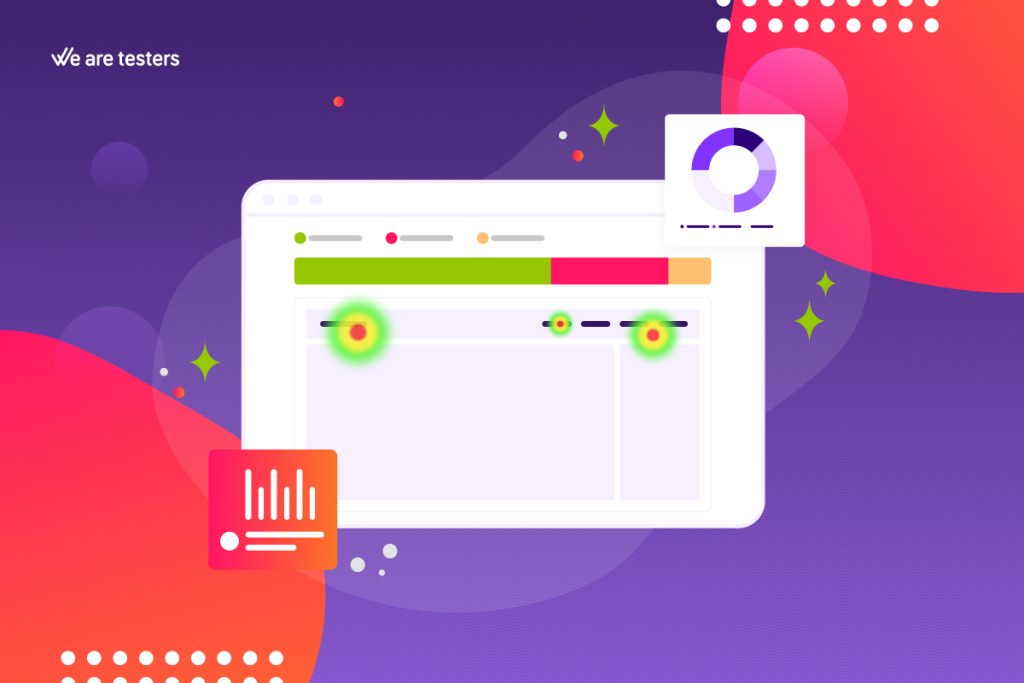
Creating your own first-click tests is now easier than ever with We are testers. We’ve just enhanced our range of UX research solutions with a new module to perform first-click testing, a fundamental quantitative test in the arsenal of UX/UI researchers to validate the usability of websites and apps. The first-click testing solution joins other UX testing methodologies already available on our research platform, such as card sorting, tree testing, or UX surveys. All in one single tool!
What is first-click testing in usability?
First-click testing is a type of usability test to assess the ease of use of a web design, app, or any other interactive system. Through the first-click test, users are asked to perform specific tasks while the location of their first click on the screen is recorded. These tasks can be as diverse as choosing the right button or finding desired information on the screen. The information obtained from this first click is used to contrast the design’s ability to intuitively guide the user and complete the mission.
Benefits of first-click testing?
First-click testing helps improve the usability of a website or app in several ways:
- Quick identification of problems: If a significant number of users click in an unexpected location or cannot find what they’re looking for within a reasonable time frame, it’s important to review the design. The earlier the test is conducted, the less development effort will have been invested in an inappropriate design.
- Adjustment of design and layout of elements: The location of the first click can reveal issues in the arrangement of visible elements on the screen. If users click in unforeseen places, UX designers can adjust the layout of elements to make it more intuitive.
- Improvement of user satisfaction: By addressing the issues identified through first-click testing, the overall user experience is improved. A more user-friendly and understandable design increases user satisfaction and reduces the likelihood of abandonment or frustration.
- Continuous iteration: First-click testing is a useful tool for iterative testing. After making adjustments to the design, the test can be repeated to evaluate whether the improvements have had the desired impact on usability.
First-click testing use cases
First-click testing is used in various situations:
- Launch of a new website or app: In these cases, it serves to verify that potential users interact effectively with the design of an environment they were not familiar with before.
- Redesign of a website or app: It is used to validate whether users who were accustomed to a specific UX design can complete tasks with the same or greater effectiveness than before.
- New features or pages: Sometimes new features are launched that may alter the user journey to complete a task, and it is necessary to ensure that their introduction does not confuse the user.
- Optimisation of online stores: When the conversion rate is everything, a few points in the users’ success rate in completing a purchase can be decisive. Evaluating the security and speed of completing a purchase is a good way to ensure that nothing interferes with the conversion path.
- Landing pages for marketing campaigns: Generating maximum impact from a campaign also depends on usability on the page that collects visits and directs them to the desired call-to-actions.
When to conduct first-click testing?
First-click testing is an easy-to-implement methodology that can be applied at different stages of development.
- First-click testing in early development stages: It is essential to note that what is being evaluated is the design’s ability to guide the user in performing a task. For this, it is not necessary for the functionality to be operational or the visuals to be final. Testing where on the screen the user clicks for success can be done with sketches or wireframes. Therefore, it is common to see click tests with Figma, Maze, and other similar design tools. Conducting click tests at this stage ensures that it can progress to the development phase with confidence.
- First-click testing in advanced developments: In later stages, a click test allows checking whether the execution meets expectations and indicates potential usability improvements to introduce before launch.
- First-click testing on already launched websites or apps: An application in production allows collecting information about where users click, but the user’s intention is unknown. With a click test, you measure where users click to complete a specific task.
The click test can also be performed with as many alternative designs as desired.
- First-click testing to contrast a design: You can organize a test with users to evaluate an already chosen design and gather information to improve it.
- Comparative first-click testing: It would be like conducting an A/B test. This case is common when the UX design team is unsure about the alternative to choose between two or more design options and resorts to a prototype test with users to choose one.
Outcomes of first-lick testing
It is important to emphasise that first-click testing is a quantitative usability test. The most important metric is the success rate, i.e., what percentage of users have successfully completed the task. This provides a figure that is easy to understand and directly comparable to other click test results that can be done at later times or for similar tasks.
Generally, a maximum time is assigned to each task. This way, you know what percentage of users did not manage to complete the task within the reasonable time assigned for it.
We are testers’ first-click tests also allow visualizing, through a heat map, the different places in the success area where users have clicked. This way, fundamental information about where to expect to find the success area on the screen is collected.
Click information is often complemented with questions to gather user impressions when performing the task, such as asking them to rate the ease of choosing the click location or explaining the reasons for choosing a specific point on the screen.
How to create a first-click test with We are testers?
Creating your first-click tests with We are testers in a few steps is very easy:
- Define what you want to know. This step is preliminary to the research itself but is crucial for test creation. Do you want to evaluate a specific page, an entire process, or several prototypes? You must be clear about the aspects you want to know in the click test.
- Choose the user sample. Our recommendation is to use a minimum of 50 users for each test. You can select them from your own database or access qualified users from the We are testers consumer panel.
- Define the tasks. Create instructions that describe what the user should achieve.
- Upload the images. Upload to the platform all the images you want, depending on the number of screens or tasks you want to test.
- Delimit the success area. Select with the mouse the part of the image you want to consider as the success area. Clicks within that area will be considered successful.
- Set the time limit. If the user takes too long to complete the task, it is also negative in terms of usability. Set a reasonable time to complete each task.
- Launch your first-click test and collect the results in a few hours. Analyze the results and make necessary decisions to improve the usability of your website or app.
As you can see, creating your own first-click tests is very easy. If you need help, our team of research experts will be by your side at all times or will program the tests for you.
Start creating your first-click tests now
With We are testers’ new solution, you can now create your own first-click tests whenever you want. Also, keep in mind that they can be combined with the rest of the UX research solutions available on the platform. This way, you can create all kinds of UX tests with a single solution.
Contact our experts to explore all possibilities. They will help you start creating your first-click tests with confidence and certainty.
Update date 23 December, 2023

